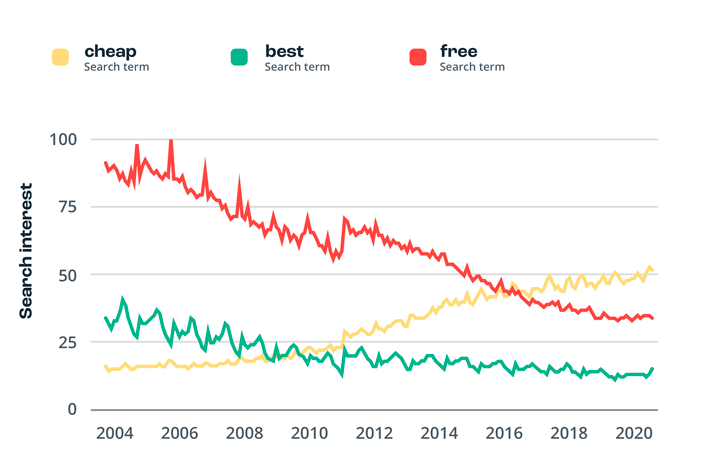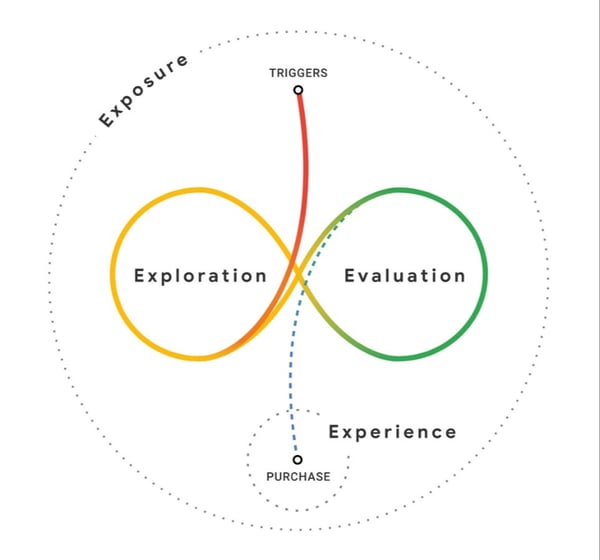
The journey of the typical online purchase
Before the age of the internet, the average buyer went out to the street to look in shops, scour shelves, and make their choice with more or less information within their reach (whatever the employee working that day wanted to share). Proximity commerce had its limitations in terms of making choices.
Now, digital commerce means that shops are open 24/7, full of ranges of products that were unthinkable before, with any information you could dream of available in a click.
Nevertheless, this has not meant that buying is now easier. It is more convenient and more full of possibilities, of course. But excess freedom also makes people feel blocked and, in the case of online shopping, overloaded with the great variety of things on offer.
Trusting the opinion of people we know has given way to depending on the experience of strangers and experts who share their reviews on social networks and websites. In the end, the buyer faces a digital purchase process that is full of steps involving evaluation, filtering, narrowing down, and selection.
Recently, Google shared a study undertaken with users from 310 countries and in 31 product categories. They analyzed the search behavior of online shoppers through search engines, comparative websites, video platforms, forums, retail websites, web aggregators, discount websites, online brand shops, and advertisements.
The results provide clues about the decision making process when shopping online in this day and age, as well as the different factors that are at play when choosing what to buy online.
→ Find out more: Other factors that influence ecommerce purchases
What the buying process is like in the digital era
The buying decision process, also known as the ‘marketing tunnel’ or ‘buying journey,’ includes the steps that the consumer goes through when deciding what he or she wants to buy and where to do so.
It is not as easy as simply saying that the buying process has clear phases for researching the product and payment. In reality, the process is chaotic and difficult to define: online, most consumers spend a lot of time changing the channels through which they check information, jumping from website to website and app to app, sometimes for days.
What happens on that buying journey can change the initial aim completely and the user may change his or her choice in the middle of the process if something better is stumbled upon.
That’s what Google’s experts call the “chaotic middle space.” It is a step that is saturated with information and unlimited options that the consumer must navigate. And to do that, the consumer has developed cognitive shortcuts based on emotional and psychological reactions.
→ Go and get those five stars: How to get more product reviews
The favorites of the online buyer: simpler is better
Amongst the findings of the Google report, it is not surprising to discover that users prefer to simplify the buying process as much as possible. But with so many options, simplicity is difficult.
The buying process changes many times while it is in course. According to Google, when product or service searches are undertaken, users tend to include one or more adjectives to modify the results. These ‘modifiers’ can refine the original search intention or adapt it to new discoveries.

It is curious to see how the search terms evolve over time. You may think that ‘cheap’ or ‘free’ is always going to be a popular search; but, in fact, searches with the words ‘the best’ have grown around the world in recent years. Psychological and sociocultural biases have also affected the product experience and digital sales process, and consumers are working with new priorities.
And the fact of the matter is that today, the internet is not a big price comparer, as many sellers think, but a big EVERYTHING comparer. That’s why it is so important to have all your product information up to date and complete with the help of PIM technology (Product Information Management).
→ You may also be interested in: Ten tips to improve your buying experience
The buying decision process proposed by Google

- Exposure: The knowledge one has about the brands or products in a certain category.
- Trigger: The thing that provokes change in the user, from a passive to an active (buying) state.
- Exploration and evaluation: This is the ‘chaotic middle space’ phase. Buyers research and compare all the options, and this happens simultaneously, jumping from one channel to the next, like a loop.
- Purchase: After the final choice.
- Experience: The impression of the buyer about the product and brand. The better the brand experience is, the more convincing it will be for the buyer – and it can even be a trigger for an initial purchase if the brand is famous.
→ Stop worrying: How to make your products stand out on Google Shopping
The 6 factors that influence the buying decision process
The psychology of buyers is something very complex that even Google doesn’t have access to. On the sales and marketing level, the best that can be done is an analysis of search trends, comparing them over time, and extracting conclusions on the most important values for the buyer.
Heuristics
These are logical shortcuts that the consumer applies to make quick, satisfactory decisions. These guidelines for choice are learned through experience: for example, we know that to choose the best cereal, we have to look at the percentage of sugars it has; or, we have to check the amount of RAM a computer has.
Authority
Consumers tend to change their minds and behavior depending on the opinions of people who are authority figures for them. This could be an influencer or an expert in the field, but in any case it helps the user to narrow down the buying decision process.
Social proof
Just like with authority, buyers tend to imitate the behavior of others – especially if they are unsure. Social networks have spread that attitude and users turn to comments and reviews by stranger or people they know to make decisions that they can’t make alone. With this in mind, reasoning like the fact that five stars means maximum quality and satisfaction also comes into play.
Immediacy
The internet has made everything accessible, but users don’t just want things, they want them quickly. Buttons and phrases citing 24-hour delivery, instant registration, and automatic discounts favor online decision-making.
→ Something to talk about: How influencer marketing works
Scarcity
Another universal psychological principal is that something scarce is better. Consumers feel attracted to things that are limited, that call for fast action in order to be one of the ‘privileged ones’ who has been able to access the product.
At no cost
While we have seen that searches with the word ‘free’ have gone down over time around the world, there are still some consumers who can resist the psychological response brought on by the phrases ‘no cost’ (for example, for shipping) and ‘free.’
Common descriptors in the buying decision process
- Ideas: Users write this term in their searches to get suggestions from a product category.
- Best: A term that can have many meanings, from value and quality to customer service.
- Differences: To compare products, generally two, like vegetarian and vegan, champagne and prosecco.
- Cheap: When the search is geared towards the price.
- Reviews: Normally when the buyer already has an idea about a specific product model or brand.
- Special deals: Consumers continue to search frequently for deals, discounts, and sales online.
- Discount code: Along the same lines as the last descriptor.
→ Analytics for ecommerce: Now extract gold from all your knowledge
Conclusion: How to influence the buyer
It is obvious that the buying decision process has become more complex with the arrival of the internet.
But that doesn’t mean it is impossible to understand and influence in one way or another. The aim for sales and marketing teams is to look beyond the buying journey, which only explains what shoppers do. It is more important to understand why they do what they do.
The omnichannel approach, or being present everywhere, is undoubtedly one of the requirements to get more involvement in the online buying journey of any given individual. You’ll have more possibilities if your brand or product appears in a marketplace or Google while the user is thinking about what to buy.
What’s more, it is important to ‘home in on’ those factors that influence the online purchase process: improving user experience, brand identity, online reputation, the value of product contents – these are all key for buyers to make decisions more quickly. Try a PIM for free to cut down on the obstacles to getting your potential customers onto your site. Do I want it? Yeah, I want it!











